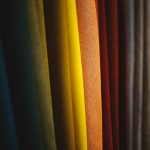Do you want to know what silk taffeta fabric is all about? Look no further! In this article, we’ll give you a concise and organized overview of this luxurious textile.
You’ll learn about the history, characteristics, production process, uses, and care tips for silk taffeta fabric.
Whether you’re a fashion enthusiast or just curious about fabrics, this article will provide you with all the essential information you need.
So, let’s dive in and explore the world of silk taffeta fabric!
Table of Contents
History of Silk Taffeta Fabric
You might be surprised to learn that silk taffeta fabric has a rich history that dates back centuries. Silk taffeta has been a popular fabric choice throughout fashion history, known for its luxurious and elegant qualities.
Silk taffeta first gained popularity in Europe during the 16th century. It was highly valued for its crisp texture, lustrous sheen, and ability to hold its shape well. The fabric was used to create extravagant gowns and elaborate court dresses, making it a symbol of wealth and social status.
During the 18th and 19th centuries, silk taffeta continued to be a favored fabric in fashion. It was commonly used in the creation of ball gowns, wedding dresses, and formal attire. The lightweight nature of silk taffeta made it ideal for creating voluminous skirts and structured silhouettes.
In the 20th century, silk taffeta remained a popular choice for special occasion garments, particularly in haute couture. Designers appreciated its versatility and ability to take on various finishes, such as pleating and embroidery, to add dimension to their designs.
Today, silk taffeta continues to be used in high-end fashion, albeit in a more limited capacity. Its timeless appeal and luxurious qualities ensure that it remains a fabric of choice for those seeking to make a statement with their wardrobe.
Characteristics of Silk Taffeta Fabric
Silk taffeta fabric has a glossy and lightweight texture, making it a popular choice for various garments. Its smooth and shiny appearance adds an elegant touch to dresses, skirts, and blouses.
Additionally, its versatility allows it to be used for both formal and casual outfits, making it a versatile option for any occasion.
Glossy and Lightweight Texture
When wearing silk taffeta fabric, you’ll notice its glossy and lightweight texture. It has a luxurious sheen that adds an elegant touch to any garment. Here are three reasons why silk taffeta fabric is known for its glossy finish and lightweight feel:
-
Smooth and Shiny: Silk taffeta has a smooth and lustrous surface that reflects light, giving it a glossy appearance. This makes it perfect for formalwear and evening gowns, as it adds a touch of sophistication.
-
Lightweight and Flowy: Despite its glossy finish, silk taffeta is surprisingly lightweight. It drapes beautifully and moves gracefully with every step. This makes it a popular choice for dresses, skirts, and other flowing garments.
-
Comfortable and Breathable: Silk taffeta is made from natural silk fibers, which are known for their breathability. It allows air to circulate, keeping you cool and comfortable, even in warmer climates.
Versatile for Various Garments
Despite its glossy finish, silk taffeta fabric is versatile and can be used for a variety of garments. Its smooth and crisp texture makes it ideal for formal wear like evening gowns and wedding dresses. The fabric’s stiffness helps to create structured silhouettes, making it a popular choice for ball gowns and A-line skirts.
Silk taffeta also drapes beautifully, making it suitable for flowing blouses and dresses. Additionally, it can be used to add volume and shape to sleeves, creating a dramatic effect. The fabric’s natural sheen adds a touch of luxury to any outfit, making it perfect for special occasions.
With so many styling options, silk taffeta is a versatile fabric that can elevate any wardrobe.
Production Process of Silk Taffeta Fabric
In the production process of silk taffeta fabric, you will explore the weaving techniques used, the dyeing and finishing methods, as well as the quality and characteristics of the fabric.
The weaving techniques employed for silk taffeta include plain weave and sometimes a twill weave, resulting in a crisp and smooth texture.
Dyeing and finishing methods play a crucial role in enhancing the fabric’s luster and durability.
The quality and characteristics of silk taffeta include its lightweight feel, high sheen, and ability to hold its shape well.
Weaving Techniques Used
Silk taffeta fabric is created using unique weaving techniques. These techniques are what give taffeta its distinctive crispness and smoothness.
When weaving silk taffeta, the weaver uses a plain weave, which means that each weft thread passes over and under each warp thread in a simple alternating pattern. This results in a tightly woven fabric that has a smooth surface and a slight sheen.
Additionally, traditional patterns are often incorporated into the weaving process to add visual interest and texture to the fabric. These patterns can range from simple stripes to intricate floral designs.
The combination of these weaving techniques and traditional patterns is what makes silk taffeta fabric so luxurious and sought-after.
Dyeing and Finishing Methods
To achieve vibrant colors and enhance the durability of your taffeta garments, you can explore various dyeing and finishing methods. Here are four techniques you can use to transform your taffeta fabric:
-
Synthetic Dyeing: This method involves using synthetic dyes to achieve a wide range of colors. It offers excellent colorfastness and allows for precise color control.
-
Natural Dyeing: If you prefer a more eco-friendly approach, you can use natural dyes derived from plants, insects, or minerals. These dyes produce unique, earthy tones and are gentle on the fabric.
-
Pigment Printing: This technique involves applying pigments directly onto the taffeta fabric’s surface. It offers vibrant and opaque colors, making it ideal for bold designs.
-
Fabric Finishing: After dyeing, you can enhance the fabric’s properties through finishing processes like calendaring or coating. These techniques improve the fabric’s luster, texture, and durability.
Quality and Characteristics of Fabric
By exploring different dyeing and finishing methods, you can enhance the quality and characteristics of your taffeta garments.
Silk taffeta fabric offers numerous benefits and drawbacks. One of the main advantages is its luxurious appearance and smooth texture, which adds elegance to any outfit. It also has a crisp and lightweight feel, making it comfortable to wear. Additionally, silk taffeta has good draping qualities, allowing it to create beautiful, flowing silhouettes.
However, the fabric is prone to wrinkling and requires careful handling to maintain its shape. It is also more expensive compared to other fabrics, due to the labor-intensive production process.
Despite these drawbacks, silk taffeta remains a popular choice for formal wear and high-end fashion due to its unique characteristics and timeless appeal.
Uses and Applications of Silk Taffeta Fabric
One of the most popular uses of silk taffeta fabric is for elegant evening gowns. Its luxurious texture and beautiful sheen make it a perfect choice for creating stunning and sophisticated attire.
Here are some key points about silk taffeta fabric and its applications:
-
Silk taffeta fabric is known for its high-quality and durability, making it a long-lasting investment for your wardrobe. The price of silk taffeta fabric can vary depending on factors such as the quality of the silk, the brand, and the color. Generally, it is considered a higher-end fabric and can be more expensive than other types of silk. The price range for silk taffeta fabric can range from $50 to $200 per yard, depending on the factors mentioned above.
-
It is important to consider the cost and quality when choosing silk taffeta fabric for your project. Silk taffeta fabric comes in a wide range of colors, from vibrant and bold hues to soft and pastel shades. This versatility allows you to find the perfect color to match your personal style and the occasion. Popular colors for silk taffeta fabric include classic black, elegant navy, romantic blush, and regal emerald. The color options are virtually limitless, making it easy to find the perfect shade for any design or outfit.
Care and Maintenance of Silk Taffeta Fabric
Now that you know about the various uses and applications of silk taffeta fabric, let’s talk about how to take care of it. Proper maintenance is essential to ensure the longevity and beauty of your silk taffeta garments or home decor items.
Silk taffeta fabric requires special care due to its delicate nature. Here are some tips to help you maintain and care for your silk taffeta items:
-
Hand washing is the preferred method for cleaning silk taffeta. Use lukewarm water and a mild detergent specifically designed for silk fabrics. Gently agitate the fabric, then rinse thoroughly.
-
Avoid wringing or twisting the fabric as it can cause wrinkles or damage the delicate fibers. Instead, gently squeeze out excess water and lay the fabric flat on a clean towel to air dry.
-
Ironing silk taffeta requires caution. Set your iron to a low temperature and use a pressing cloth to protect the fabric. Avoid using steam as it can leave water spots.
-
Store silk taffeta items in a cool, dry place away from direct sunlight. Avoid hanging them as it can cause stretching. Instead, fold them neatly and store them in a breathable fabric bag or acid-free tissue paper.
Where to Buy Silk Taffeta Fabric
Looking for a place to purchase silk taffeta? You can find it at specialty fabric stores or online retailers that offer a wide selection of luxurious fabrics. Here are four options to consider when looking for silk taffeta suppliers:
-
Specialty fabric stores: These stores specialize in offering a wide range of fabrics, including silk taffeta. They often have knowledgeable staff who can assist you in finding the perfect color and quality for your project.
-
Online retailers: Online shopping provides convenience and access to a vast selection of silk taffeta fabrics. Many online retailers offer a variety of colors and patterns to choose from, making it easy to find exactly what you need.
-
Silk taffeta wholesalers: Wholesalers often supply fabrics to businesses and individuals at discounted prices. If you need a large quantity of silk taffeta or are looking to start a business selling fabric, purchasing from a wholesaler may be a cost-effective option.
-
Fabric trade shows: Attending fabric trade shows can be an excellent way to discover new silk taffeta suppliers. These events bring together a variety of fabric vendors, allowing you to compare different options and find the perfect silk taffeta fabric in a range of colors.
With these options, finding the perfect silk taffeta fabric in your desired color is easier than ever. Whether you prefer to shop in-store or online, make sure to explore different suppliers to find the best quality and price for your project.
Conclusion
In conclusion, silk taffeta fabric is a luxurious and versatile material that has been used for centuries. Its crisp and smooth texture, along with its shimmering appearance, make it a popular choice for formal wear and home décor.
The production process involves weaving silk threads in a specific way to create the characteristic ribbed pattern. To care for silk taffeta fabric, it is important to handle it delicately and avoid exposing it to moisture.
You can purchase silk taffeta fabric from various fabric stores and online retailers.
- Is Kona Cotton Fabric Good for Making Face Masks? A Factual Look - June 20, 2025
- Shopping for Kona Cotton at Joann Fabrics: What You Need to Know - June 20, 2025
- How to Find Discontinued and Out-of-Print Kona Bay Fabrics - June 20, 2025






